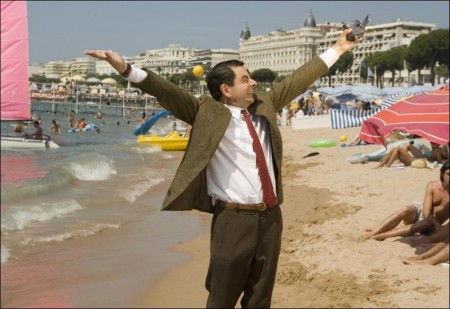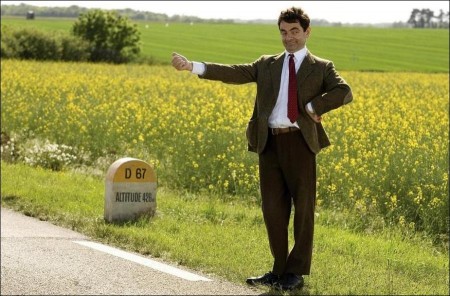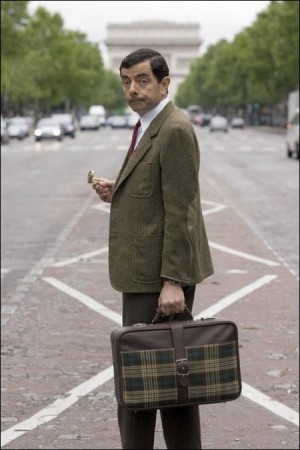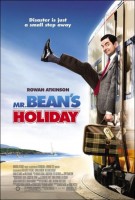Tagline: Disaster is just a small step away.
On a rainy afternoon in England, Mr. Bean is delighted to win First Prize in his local church raffle; a week’s holiday in the South of France, and a brand new video camera. He will stay in Cannes, at the height of its famous film festival. He catches the Eurostar to Paris, filming everything with his new video camera. At the Gare de Lyons, he asks another passenger to film him as he boards the train for Cannes. The man is Russian film director Emil Duchesvsky, who is travelling to Cannes to be a judge at the Film Festival. Emil obliges, but in the confusion of filming, Emil gets left on the platform as the train pulls out.
Mr. Bean is heading South when he realises that Emil’s son Stepan, aged 10, is on the train without his father. Neither speak each other’s language. Mr. Bean and Stepan get off at the next station to wait for Emil, but the next train is an express and Emil is whisked on to Cannes. When Mr. Bean and Stepan board the next train, Mr. Bean leaves his money, his ticket and passport on the platform. They are thrown off for not having tickets, and left lost and penniless in France.
Stepan’s father Emil reports Mr. Bean to the police and a national manhunt is launched, to find his son. Stepan and Mr. Bean strike up an unlikely friendship. Stepan is quick-witted and resourceful; they work well together, and soon earn enough money busking to catch a bus South to Cannes. Except that Mr. Bean’s ticket somehow gets stuck on the foot of a chicken and he misses the bus…
Without Stepan, and lost in the vast French countryside, Mr. Bean hitches his way South. At night he wanders into a village and falls asleep under a haycart. The next morning, he wakes to find himself in what seems to be a perfect French village, but is in fact the set of a yoghurt commercial. The director is American film maker and narcissist, Carson Clay, who is earning some cash before travelling South to attend the Cannes Film premiere of his navel-gazing art house cop movie, Playback Time.
Mr. Bean hitches a lift south with bit-part actress Sabine, who played a waitress in the yoghurt commercial, and is going to Cannes to attend the premiere of Playback Time, in which she has a small role. When Bean is reunited with Stepan at a motorway service station, all three of them drive south through the night.
Arriving in Cannes, they see a TV newsflash: Mr. Bean is a wanted man, and the whole of France is looking for him and Stepan. There are roadblocks ahead. They have to get past them to the premiere of Playback Time, and return Stepan to his father, without Bean being arrested.
Disguised as Sabine’s mother and daughter, Mr. Bean and Stepan successfully pass through the roadblocks, but with only one ticket between, only Sabine is allowed into the premiere.
Bean and Stepan sneak in round the back. Playback Time is boring the audience to tears. Leaving Stepan behind the screen, Bean tries to attract Emil’s attention without alerting the guards. When Sabine’s only scene is cut, Bean decides to help her. Hiding in the projection room from the guards, he begins to project his video footage on to the big screen, to reinsert Sabine into the film.
The combination of film and video catches the audience’s attention for the first time, but Carson Clay is apoplectic with rage. He and the guards break into the projection room to stop Mr. Bean, but he escapes. Walking over the heads of the audience, he reaches the stage just as Stepan appears from under the big screen. The crowd erupts into applause.
Carson Clay’s Playback Time is hailed as a groundbreaking classic, Sabine is feted as a star and Stepan is returned to his delighted mother and father.
And Mr. Bean? He slips away from the scenes of celebration to the beach. At the water’s edge, he rolls up his trousers and smiles: at last his holiday can begin.
Production Notes
Mr Bean, who began life on British television screens in 1990, has become a worldwide star thanks to Rowan Atkinson’s unique ability to marry endearing physical comedy and slapstick with a lovable personality. The series sold around the globe, which propelled co-writers Rowan Atkinson and Richard Curtis to create a feature film, Bean: The Ultimate Disaster Movie, which saw the star embroiled in the art world in Los Angeles.
Following the huge international success of the first Bean film – over $260 million worldwide on its release in 1997 – it was only a matter of time before the film’s creators decided to give the character a second big screen outing. However, this time the filmmakers were very keen that they would not retread the same path, both stylistically and narratively.
“We always felt that there was another movie to be made with Mr Bean, but it would be a very different film from the first one,” explains Rowan Atkinson, the award-winning actor and writer who co-created the comedy character with Richard Curtis. “We did the first movie 10 years ago and if we were going to make a sequel it would have been logical to make it eight or nine years ago rather than now, but it just took time to get round to thinking about it.”
It wasn’t hard for Atkinson to play the character again, despite a decade having passed since he last did so. “I haven’t visited him much since the last film – the last time I played the character was on a British children’s TV programme about two years ago. But I didn’t find it difficult in finding him again, understanding him and knowing how he would behave in any given situation. I no longer have to work on him or think about him and how he’s going to react. I instinctively know him, his childish instincts are very strong to me. The challenge of filming for me is being at the centre of the film and being in virtually every scene and making sure that the relationships between Bean and the people he meets work and work well.”
Atkinson was also intrigued by the chance to explore a different style of filmmaking that a new film would offer. “I always believed that there was a European style movie to be made with Mr Bean,” he says. “The first movie was more American in style. It had the story, format and tone of an American family comedy. I was always interested in the idea of Bean being the pro-active element, being the element driving the story, rather than him being a reactive element, a sort of satellite figure who was in the background while the story was being driven by other characters, which was the shape of the first film.”
Tim Bevan, producer and co-chairman of Working Title Films explains how the creative elements came together: “Once we had finished Johnny English I suggested to Rowan that we develop two films one of which would be a sequel to Mr Bean.” Both he and Richard Curtis felt that to make another movie about the same character you would want to aspire to a different level of creative ambition and you would want to make it as pure and as cinematic as possible. “There’s a real simplicity about the character of Bean,” continues Bevan, “someone then had the genius idea of involving Simon McBurney who co-founded Theatre de Complicite. He has a lot of experience with movement and mime. Essentially both he and Rowan strive to do the same thing, which is to engage the audience through more or less silent comedy.
McBurney was immediately intrigued by the prospect of collaborating with Atkinson “Rowan is absolutely unique as a performer. I first met him and saw him work in the early 1980s when I was very young and I was mesmerised by his stage work because he was one of those performers who could go on stage and nothing would happen and you would be completely entranced, roaring with laughter, but you didn’t know what he was doing. He has a unique physical presence and an incredible imagination as a performer. He will suddenly see a way of reacting to something which nobody else might see – he’s in character and he starts to play with it. He’s constantly playing and inventing and that’s what makes him very special.”
Working with a character who expresses himself through action rather than the spoken word was also a strong incentive. “I absolutely love silent comedy in all its myriad forms,” says McBurney, who has always wanted to make an homage to silent film comedy. “One of the first things I did with Rowan was to sit down and watch films by Buster Keaton, Charlie Chapin, Harold Lloyd and Carl Valentine. We also watched bits of Jacques Tati and I thought it would be thrilling to try and make a film in which Bean hardly says a thing. He is the most wonderful character when he’s doing something, rather than saying something.”
The filmmakers were aware that comparisons might be made with Tati’s classic French comedy Monsieur Hulot’s Holiday, but as Rowan Atkinson says: “The film is driven by Bean’s ambition to reach a lovely beach. It wasn’t particularly inspired by Monsieur Hutot’s Holiday. In many ways the essence of that film was that he was travelling for 5 minutes and was on the beach for an hour and a half, whereas we travel for an hour and half of the film’s running time and then we’re on the beach for 5 minutes. So it’s an inverse of that film.”
As the collaborators began to play with possible storylines, one key element emerged: the introduction of a female character. “Before Simon became involved we thought that maybe it should be a film about Bean and a woman,” says Bevan. “When Simon came on board he felt that Bean was not a character that would fall in love on screen, but he found the idea that there should be a woman involved in the story somewhere very interesting. Simon and Rowan decided that the film should be a journey and that we should keep it as simple and as pure as possible. Our hero would be going on holiday to the seaside and the film would be entirely about his journey of getting to the beach and all the cock ups and problems that happen along the way.”
“As in all silent comedy there is a simple desire that drives the story, in this case Bean’s desire to go on holiday in France,” McBurney continues. “The story is really motivated by action, very much in the vein of Buster Keaton – he has one idea, he falls in love and then he pursues the girl – or Chaplin in The Goldrush where he sets off in order to make some money. There’s no psychological build-up, it’s just really very, very simple In Mr Bean’s Holiday he is trying to get somewhere and he simply cannot get there.”
Those initial discussions also brought the team to two further elements: there would be dialogue in the film but it would be either French or another language that few people understand; and Bean would have three words of French which would be Oui, Non and Gracias.
“It was always a slight source of regret to me that Mr Bean spoke as much as he did in the first film,” says Atkinson. “By putting Mr Bean in an environment where he doesn’t speak the language he would have to deal with every situation in a silent way, and that way we would be able to maintain a bit of purity to the way Mr Bean works.”
The team also decided that Mr Bean would come across two characters on his journey, a boy and a woman. The boy, played by Max Baldry, becomes Bean’s responsibility as he struggles to reunite him with his family, and can’t speak English; the woman, played by Emma de Caunes, is not a romantic interest but is swept up in Bean’s adventure.
“We’ve been extremely lucky with the casting of the roles,” says Atkinson. “Emma de Caunes is everything that we would wish. She manages to convey tenderness but has a volatility which is our view of the French actress. Max Baldry is very, active, very lively, very on the ball and very natural.”
Co-producer Caroline Hewitt concurs: “For Sabine, we needed somebody neither too young nor too mature. There was an age beyond which it was not going to be that interesting and too young would be a bit too cute. Emma just hits that middle, she’s exactly the right age. She also understands the peaks and troughs of an acting career which was useful for the character. Max was the first boy to come through the door. It completely changed everything because we realised he spoke Russian which fitted in with us wanting a boy who was fluent in another language. He really has a fantastic energy. He has a lot of composure and he’s quite precocious, he knows exactly what he’s doing.”
For Emma de Caunes, one of France’s rising stars who most recently starred in The Science of Sleep, the decision to accept the role of Sabine was very simple, as she was already very familiar with the character of Bean, thanks to her father, TV presenter Antoine de Caunes. “When I was 15 or 16, my dad used to bring me back the tapes of Bean and I was really mad for it. He really made me laugh so I’m a huge fan. I love the fact that he’s really quite innocent, like a child and we can all understand him. And there’s a lot of poetry in the film. It was also an opportunity to work with Rowan who is an amazing actor. The role is not just burlesque, he’s a fantastic actor and I really loved watching him working and improvising. For me he’s like a Charlie Chaplin.”
Max Baldry, making his film debut, was also a connoisseur of the Mr Bean television series: “I grew up in Poland and we used to watch Mr Bean. He’s known all over the world. One day when we were filming at the Arc de Triomphe a coach of Japanese tourists went by and they were all opening the windows and saying `Mr Bean! Mr Bean!’ It was really funny. It’s very exciting for me be acting with him, although I find him so funny it’s sometimes very hard for me not to laugh.”
For the character of Carson Clay, the filmmakers approached Willem Dafoe, one of America’s top actors whose films have included the award-winning The English Patient, The Life Acquatic with Steve Zissou and Spiderman. “It’s a fun character,” explains co-producer Caroline Hewitt, “because it’s a caricature of the kind of pretentious art house film director who has to make commercials to make ends meet and then makes the most boring art house movie known to man. Willem came to it so generously and openly and immediately got it. We gave him a girlfriend who’s about 10 feet taller than him for the red carpet scene at the festival. He understood and went along with it.”
Dafoe needs little persuading to accept the part. “I’m a great fan of Rowan’s,” he says, “and I really loved the part. I play an art house prima donna, a filmmaker who stars in his own films, but who is making a yoghurt commercial for money. In a way he’s the straight man to Mr Bean, who is a constant thorn in his side.”
The film also appealed because it was a chance for Dafoe to step outside his comfort zone in terms of genre: “It’s different to what I’ve done before and that usually helps whet my appetite. It felt like an adventure because I had to learn a new approach. It’s physical comedy and that’s quite liberating. It really was a lot of fun.”
Taking the helm is Steve Bendelack, director of British TV hits Little Britain and French and Saunders, and the feature film `League of Gentlemen’s Apocalypse’. He was, according to producer Tim Bevan, the obvious choice: “We wanted to find somebody who had a sense of comedy and worked with comedic actors, but also had a real sense of cinema. Steve was the right person.”
The challenge for Bendelack was to see Bean in a new environment: “It was interesting to me to combine the tried and tested things that Rowan does as Bean with some things that he hasn’t done before. We see him in a much wider context in this film. It was interesting to put him in a real world with real characters and to play on that juxtaposition. I was interested by the subtlety of his performance. It’s a collaboration because he knows the character so well. There is a part of his personality that is genuinely extrapolated into this character, so that’s very interesting to work with.”
Co-producer Caroline Hewitt testifies to the ease with which Rowan slips into character: “Rowan’s focus and concentration are extraordinary. During filming I got to know Rowan and to watch him transform into Mr Bean was almost a shock. It’s a complete personality take-over. It’s not like with other actors who explore their characters. Rowan knows exactly who Bean is, he can say with complete authority, `I would not, as Bean, do this’, he is completely embedded with the character. It’s fascinating to watch.”
The film is set almost entirely in France, but the filmmakers were keen to portray a France that would subvert Bean’s – and perhaps the audience’s – preconceptions of the country.
“We talked a lot about the idea that Bean would have a clichéd idea of France,” says McBurney. “His idea of France is epitomised by the yoghurt commercial that he ends up disrupting, a France with peaceful ancient villages set in perfect landscapes, full of men wearing berets outside the local café drinking pernod. Bean’s France turns out to be a fiction. The real France is something different. I lived in France for a long time and I felt it should be portrayed as a very modern country, which is extremely urbanised and with this incredible sense of design. The real France is motorways, the highly modern architecture of La Defense and the Cannes Film Festival. Of course, there are some simple jokes which you could only do about France, things to do with the cyclists, hitchhiking or the food. The key to it was seeing Bean interact with a culture which is not his own. Very often in the TV shows he was put into an unfamiliar situation. Now he’s in an unfamiliar country. So the whole country becomes the situation and anything is potentially disastrous.”
Atkinson adds: “France is a very big country with a relatively small population for its land mass and there are many spectacular and beautiful vistas which we have attempted to capture. We tried to capitalise on some of the extraordinary architecture and landscapes that France has because there is something inherently funny about this small figure of Mr Bean set in this vast context. I think it was Charlie Chaplin, who said `Life is a tragedy in close-up but a comedy in a long shot’ and there is that element that the more you draw back, the more inherently amusing the figure in the landscape becomes.”
Filming took place over 12 weeks during the summer of 2006, in London, Paris, the Luberon and Cannes, where both the beaches and Le Palais, best known for hosting the Cannes Film Festival, were used.
For the first time ever, the crew were even allowed to film on the red carpet during the festival, thanks to the organisers of the film festival. “It was amazing that we were allowed to film there,” says Hewitt. “Giles Jacob, the festival president, turned out to be a fan of Mr Bean and just liked the idea. They were incredibly welcoming and helped in every single way they possibly could. We filmed one scene live as a real film entourage were going up the red carpet – we cheekily just jumped on the back of it. And for one of the most complex scenes we took over the equivalent of three public beaches on the Croisette.”
For Emma De Caunes it was a strange experience to be filmed climbing the red carpet as a real film was receiving its premiere: “It was really exciting because nobody really knew that we were shooting a movie. People know me a little in France so they were shouting `Emma!’ And I was thinking, `No I’m Sabine!’ It was funny. It was great to have some of the craziness of Cannes during the festival in the film.”
Setting the film in Cannes was just one way that McBurney wanted to make Mr Bean’s Holiday an homage to the art of filmmaking. Throughout the film Bean has a video camera and part of the narrative of the film is told through the images that Bean takes on the video camera.
“The great silent comedians always played with the idea of cinema,” says McBurney. “Nowadays, when somebody goes on holiday they always take a videocamera. It gave us the perfect means to play with the frame. When Bean has a video camera in his hand it becomes very interesting because you can see what he is looking at and that becomes a window into what he’s thinking and feeling. And it pays off by ending up at a film festival. And so inevitably film and the film collide. It provided us with an amusing and clever way of playing with the idea of what is real and what is not real.”
“A very important element of the story is that Mr Bean has a video camera with him at all times,” continues Atkinson. “Effectively two movies are playing out throughout our film – there is the film that we are making and then there’s the movie that Mr Bean has made of his experiences on the road. What’s interesting is the way those two merge and overlap and intertwine and so there is this sense in which the nature of movies and moviemaking is at the centre of the story.”
“I hope that the film is as true, if not more true to the character and what people have enjoyed about the character, than anything we’ve done before,” concludes Atkinson. “I hope it’s going to be a more pure representation of Bean than we’ve seen. I hope the audience will be with the character and rooting for him more and sympathizing with him more than you ever have before. That is my hope.”
Production notes provided by Universal Pictures.
Mr. Bean’s Holiday
Starring: Rowan Atkinson, Willem Dafoe, Emma De Caunes, Jean Rochefort, Karel Roden
Directed by: Steve Bendelack
Screenplay by: Robin Driscoll, Hamish McColl
Release Date: August 31th, 2007
MPAA Rating: PG for brief mild language.
Studio: Universal Pictures
Box Office Totals
Domestic: $33,302,167 (14.5%)
Foreign: $196,434,177 (85.5%)
Total: $229,736,344 (Worldwide)



